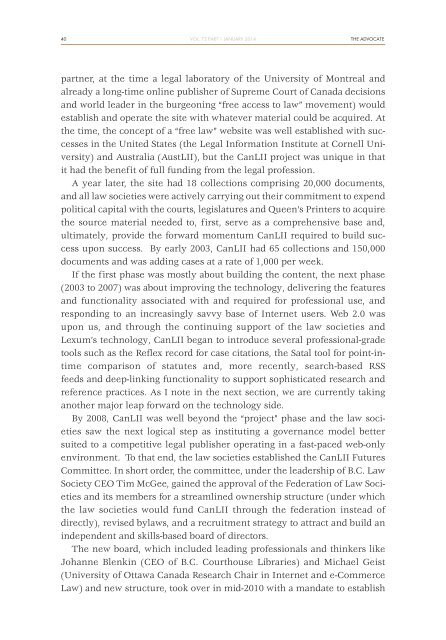Advocate Jan 2014
Advocate Jan 2014
Advocate Jan 2014
You also want an ePaper? Increase the reach of your titles
YUMPU automatically turns print PDFs into web optimized ePapers that Google loves.
40 VOL. 72 PART 1 JANUARY <strong>2014</strong><br />
THE ADVOCATE<br />
partner, at the time a legal laboratory of the University of Montreal and<br />
already a long-time online publisher of Supreme Court of Canada decisions<br />
and world leader in the burgeoning “free access to law” movement) would<br />
establish and operate the site with whatever material could be acquired. At<br />
the time, the concept of a “free law” website was well established with successes<br />
in the United States (the Legal Information Institute at Cornell University)<br />
and Australia (AustLII), but the CanLII project was unique in that<br />
it had the benefit of full funding from the legal profession.<br />
A year later, the site had 18 collections comprising 20,000 documents,<br />
and all law societies were actively carrying out their commitment to expend<br />
political capital with the courts, legislatures and Queen’s Printers to acquire<br />
the source material needed to, first, serve as a comprehensive base and,<br />
ultimately, provide the forward momentum CanLII required to build success<br />
upon success. By early 2003, CanLII had 65 collections and 150,000<br />
documents and was adding cases at a rate of 1,000 per week.<br />
If the first phase was mostly about building the content, the next phase<br />
(2003 to 2007) was about improving the technology, delivering the features<br />
and functionality associated with and required for professional use, and<br />
responding to an increasingly savvy base of Internet users. Web 2.0 was<br />
upon us, and through the continuing support of the law societies and<br />
Lexum’s technology, CanLII began to introduce several professional-grade<br />
tools such as the Reflex record for case citations, the Satal tool for point-intime<br />
comparison of statutes and, more recently, search-based RSS<br />
feeds and deep-linking functionality to support sophisticated research and<br />
reference practices. As I note in the next section, we are currently taking<br />
another major leap forward on the technology side.<br />
By 2008, CanLII was well beyond the “project” phase and the law societies<br />
saw the next logical step as instituting a governance model better<br />
suited to a competitive legal publisher operating in a fast-paced web-only<br />
environment. To that end, the law societies established the CanLII Futures<br />
Committee. In short order, the committee, under the leadership of B.C. Law<br />
Society CEO Tim McGee, gained the approval of the Federation of Law Societies<br />
and its members for a streamlined ownership structure (under which<br />
the law societies would fund CanLII through the federation instead of<br />
directly), revised bylaws, and a recruitment strategy to attract and build an<br />
independent and skills-based board of directors.<br />
The new board, which included leading professionals and thinkers like<br />
Johanne Blenkin (CEO of B.C. Courthouse Libraries) and Michael Geist<br />
(University of Ottawa Canada Research Chair in Internet and e-Commerce<br />
Law) and new structure, took over in mid-2010 with a mandate to establish


